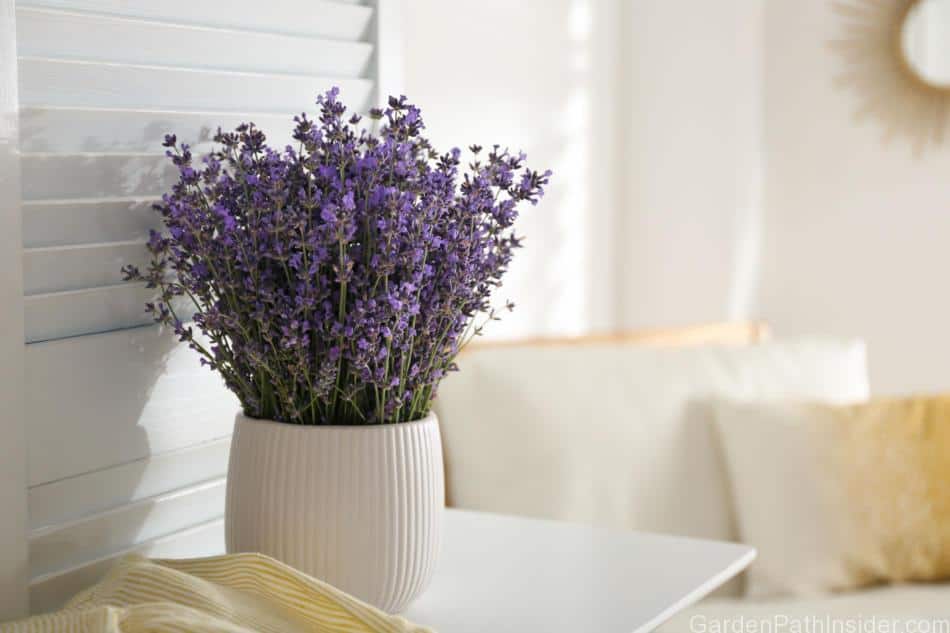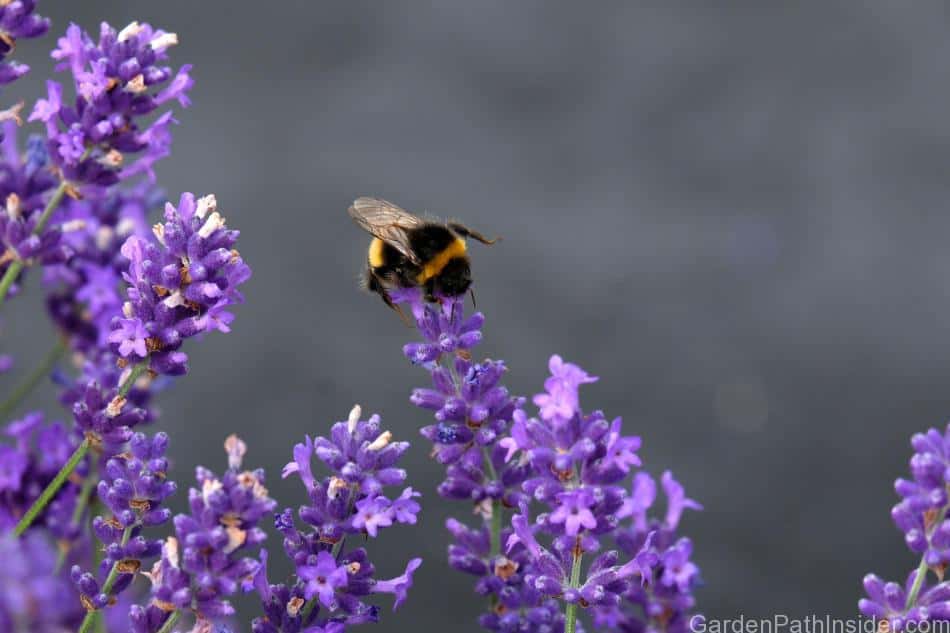
Lavender is a wonderful plant to grow in pots or container gardens. The Lavender plants can withstand hot dry conditions, and still provide beautiful purple flowers against grayish-green leaves. Growing lavender in pots is a great way to add their color and relaxing fragrance to your garden, with the flexibility to rearrange and redesign your garden with the changing seasons.
Lavender can be grown in pots or container gardens. Potted Lavender requires soil that is well-draining and neutral to mildly alkaline. Place potted lavender in a location with 4 to 8 hours of direct sunlight per day. Potted lavender grows best in temperatures between 60°F to 70°F (15.5°C to 21°C) during the day and nighttime temperatures above 40°F (4.4°C).
Growing lavender in pots adds beautiful color and fragrance to your garden all season. Growing the lavender in pots makes the plants easier to move around your garden as the seasons change, and safely store and winterize the lavender plant during the cold winters.
Best Lavender for Pots
The list below will provide some guidance on Which lavender is best for pots in your garden.
The first step is to choose the type of lavender to plant in your pots and container garden. There are dozens of species of lavender with several hundred varieties.
The size of lavender varieties rang from small dwarf varieties that can be potted and placed on top of your backyard picnic tables, to the large varieties that are grown on beautifully sprawling lavender farms.
French lavender (Lavandula Dentata): French lavender grows up to 3 feet tall and 3 feet wide (91cm tall, 91cm wide), with blooms outlasting most other varieties of lavender, blooming from summer through into fall. The colors and fragrances of the French lavender are not as pronounced as other varieties, and French Lavender is not as tolerant of the cold as other species.
English lavender (Lavandula angustifolia): English lavender is the traditional lavender that we see used in household items like soap, candles, and essential oils. The colors and fragrances of English lavender are very prominent and this hearty variety of lavender can grow up to 3 feet tall and 3 feet wide (91cm tall, 91cm wide).
Spanish lavender (Lavandula stoechas): Purple ribbon Spanish lavender is a larger variety of lavender the grows to a mature height up to 16 inches (40cm) tall with a spread of up to 18 inches wide (45cm). Purple ribbon Spanish lavender blooms with dark purple flowers and a sweet strong lavender aroma. This lavender requires a slightly alkaline soil and tends to tolerate heat better than other varieties.
Canary island lavender (Lavandula canariensis): Canary Island Lavender is a noticeably different variety of lavender with a woody shrub-like appearance, bright green leaves, bright blue flowers, and almost no “Lavender” scent in the leaves or flowers. This lavender blooms for a long period of time during the season starting in Spring, and year-round in some climates. The ferny leaves grow up to 30 inches (76cm) tall and up to 30 inches (76cm) wide.

Soil Needs for Potted Lavender
Lavender soil mix recipe for your potted plant. Lavender requires neutral to mildly alkaline soil that is well-draining. Lavender is native to the Mediterranean and can be grown in pots using moderately fertile sandy topsoil from your yard, or a well-draining potting soil from online or the local home store. Both types of soil have worked well, the key is Lavender requires a well-draining soil that is neutral to mildly alkaline.
Container Needs for Lavender
Plant lavender in a pot with a diameter of 4 to 8 inches (10 to 20 CM) larger than the lavender plant root cluster. If the pot is too small the roots will be confined in the pot and the growth will be stunted, the lavender plant will then need to be transplanted to a larger pot.
If the pot is too large, the risk of waterlogging the root system increases as more soil will hold moister for a longer period. Sitting water in the potting soil will cause the roots to rot and the lavender will die.
Clay pots are my first choice for potted plants grown inside or outside. The clay pots are porous enough to let excess water permeate through the walls of the clay pot, avoiding standing-water in the root system. Be cautious as you can still overwater plants in clay pots if you are not careful. Clay pots usually have only one large drainage hole in the center bottom of the pot.
If you are using plastic pots or planting containers you may have to drill holes in the bottom of the container. The holes need to be large enough to not get clogged by the soil or roots.
After the holes in the bottom of the pot are drilled out, place a small barrier inside the pot over the drainage hole to prevent the soil and roots from blocking the drainage ports. I use pieces of broken clay pots to protect the drain holes, but you can also use a few small rocks, or mesh wire. Do not completely block the drain hole, just lay the objects over the drain ports.
Adding a DRIP TRAY under an indoor container plant will let the excess water run through the plant and then reabsorb as needed later in the day.
Watering Needs for Potted Lavender
Water the potted lavender plant with enough water to saturate the soil.Only water the plant when the soil starts to dry out. If the soil is damp your lavender does not need water. If the leaves start to change to a yellowish color or droop AND the soil is moist, then your pot or planting container could be retaining too much water.
Standing water in the soil will cause the roots to slowly rot and the plant will die. Water thoroughly as needed checking the soils moister levels daily.
Place the pot on a clay dish or tray to collect the pots excess water. You can use this for both indoor and outdoor plants. The tray under the pot collects the water that runs through the soil when watering. The excess water in the tray re-absorbs into the soil as needed.
Check the soil daily by touching the soil a few inches from the stem of the Lavender. Keep the soil slightly damp for optimal growing conditions for lavender plants. Make sure to not damage the root system while you are checking the plant’s water levels. A light press on the soil will tell you the plant’s hydration levels.
Daily Sunlight Requirements for Lavender
Lavender needs full sun for at least 4 hours per day. However, 6 to 8 hours of full sun each day will produce healthier lavender plants. Place the lavender plants in an open area of your garden slightly away from walls or other tall bushes for maximum sunlight each day. One of the benefits of potted lavender is the ability to move the pots around your yard throughout the season to chase sunlight, as daylight hours grow shorter.
Where Does Lavender Grow Best Indoors?
Potted lavender grown indoors should be placed by a large window that gets 4 to 6 hours of direct sun each day. Take care to rotate the plant every few days by simply turning the plant 90 degrees in place to get equal sun exposer to all sides of the plant.
Lavender can thrive in dry climates and will do well in the dry climates of our homes. Water the plants as needed when the soil starts to dry out. For more information read the article we published on growing lavender indoors.
Growing Lavender in Hanging Baskets
Growing lavender in hanging baskets is a creative way to display your lavender indoors or outside. Hanging lavender can bring beautiful colors and fragrances into your home, and hanging lavender is just as easy to care for as potted lavender. Read our article on hanging lavender to help get started.
Cover image: Beautiful lavender flowers_© Olga Yastremska/123rf.com
